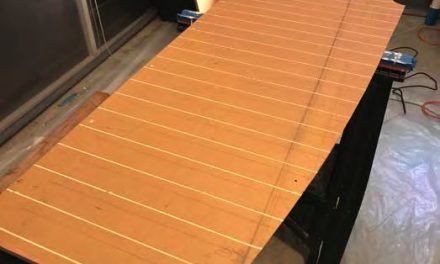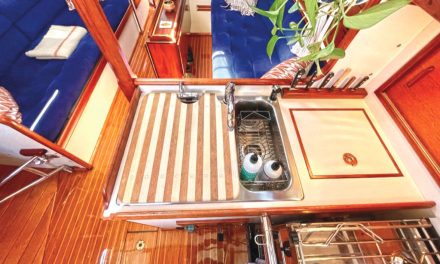 They hold up the shrouds that hold up the mast
They hold up the shrouds that hold up the mast
Spreaders are struts attached to the sides of a mast to hold the shrouds away from the mast and increase the angle at which they meet the mast. The greater the angle between shroud and mast, the lower the shroud tension required to provide lateral support and, therefore, the less the compression on the mast. This means the shrouds’ diameter and the mast section can be smaller, thereby reducing windage and weight aloft.
A boat’s beam limits the length of the spreaders, so boats with very tall masts usually have more than one set of spreaders to achieve the desired angle of attachment at the masthead. Another reason to use multiple spreaders is to allow the shrouds to be mounted inboard to permit closer sheeting angles for headsails.
Very often, the short stout mast on a gaff-rigged boat will not need spreaders, but most high-aspect-ratio Bermudan-rigged boats will need at least one pair.
Originally, spreaders were called crosstrees, but that term is not used on modern recreational sailboats.
Spreader geometry
Spreaders are metal (usually aluminum), wooden (usually spruce), or composite (usually carbon fiber) and are attached to the mast on spreader bases. On some racing boats that rely on mast bend for flattening the mainsail, the spreader bases allow the spreaders to swing fore and aft to follow the masthead, but on most cruising boats the spreaders are fixed.
The angle between a spreader and the shroud it supports should be the same above and below the spreader. Bisecting the shroud’s angle in this way ensures that the only force on the spreader is compression and results in the spreader being canted slightly upward from its base. On boats with two (or more) sets of spreaders, intermediate shrouds are fitted that lead from the base of the upper spreader and around the lower spreader so all the spreaders are fitted at the same angle.
In a common arrangement, the shroud fits in a groove in the outer end of the spreader. The shroud should be seized to the spreader to prevent it from falling out of the groove when the shroud is to leeward and slack. Monel seizing wire is good for this purpose.
Sometimes a spreader lift is used to maintain the correct spreader angle. This is a short cable leading from the spreader to a point higher up the mast.
Diamonds and jumpers
Diamond shrouds or stays are used to support and stiffen the upper section (or panel, to use the engineering term) of a fractionally rigged mast. Viewed from forward or aft, they form a diamond shape and are held forward and athwartships by a triangular spreader, called a jumper strut, fitted just above the headstay attachment point. The diamond stays lead from just below the masthead, over the jumper strut, and back to the mast just above the upper spreaders.
Diamond stays are sometimes seen supporting the upper panels of the masts on older masthead rigs. In this application they are in line with the shrouds so as not to interfere with the headstay and headsail. Few sailboat rigs are built this way today.
Genoas can brush against the spreaders when trimmed close or when tacking, and the mainsail lies on them when it is eased well out. A smooth plastic (usually vinyl) spreader boot fitted at the outer end of the spreader will protect the sails from chafe damage that would arise from their rubbing against the end of the spreader or the seizing wire that holds the shroud in place. The spreader boot cannot be made completely watertight and water that gets inside it can lead to corrosion. Removing the spreader boot and inspecting the shroud should be part of a regular rigging check.
Determining the location and the size of the spreaders, as well as the size of the mast section and shroud diameter, is not something a do-it-yourselfer should attempt. Leave that to a naval architect. Any replacement shroud should be made of the same material as specified in the boat’s original design. If type-316 stainless-steel wire rope is used to replace a type-304 stainless-steel shroud, an upgrade in the diameter of the cable and associated fittings might be required because, although type 316 has better resistance to tropical weather, it does not have as high a breaking strength as type 304. Again, a professional rigger or a naval architect should be consulted as to whether or not that might be necessary.






